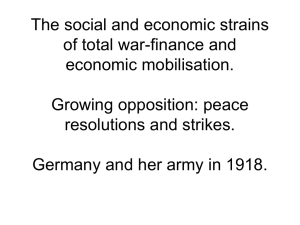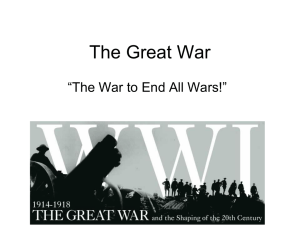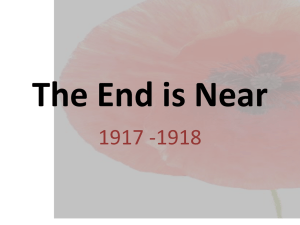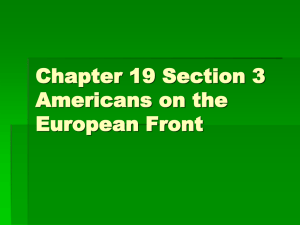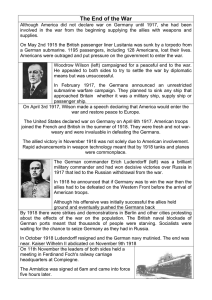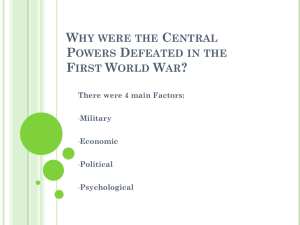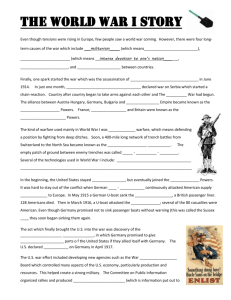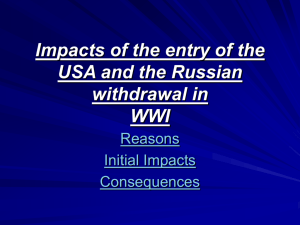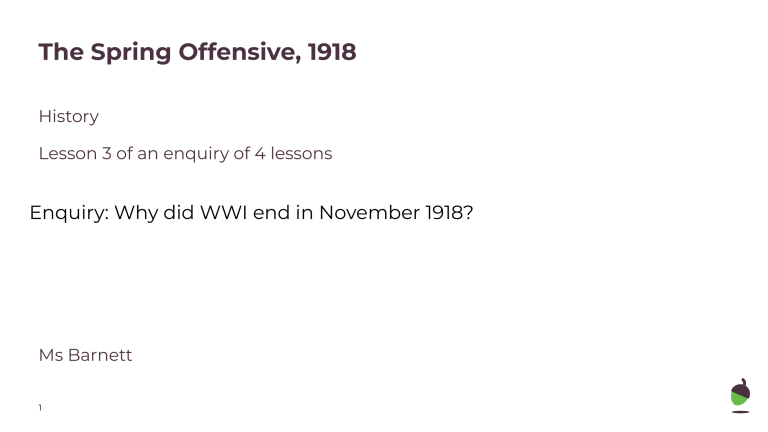
The Spring Offensive, 1918 History Lesson 3 of an enquiry of 4 lessons Enquiry: Why did WWI end in November 1918? Ms Barnett 1 1917 - A German Advantage? By the end of 1917 Germany held the advantage in WWI. Although the USA had declared war on Germany in April 1917, the US army was not yet ready to fight. Their army needed time to expand and be trained. They would not arrive in Europe in large numbers until the Spring of 1918. Furthermore the Russian Revolutions in 1917 had led to Russia making peace with Germany. The Treaty of Brest-Litovsk in 1918 gave Germany control over Russian coal mines and factories too. German troops were now able to focus solely on the Western Front. Germany and the Central Powers entered into 1918 with an advantage. 2 1918 - German Resources Things were not as positive for Germany as they seemed. Resources were key for success - both for the army and for civilians on the homefront. From the beginning of the war in 1914 both the Allied Powers and the Central Powers had tried to prevent the other from getting essential supplies. It was hoped this would force an enemy into an early surrender. Britain had used its navy to blockade German ports since 1914. This meant that by 1917 German civilians were experiencing severe shortages. 300,000 German civilian deaths were recorded due to malnutrition between 1914-1918. In reality it was probably higher. 3 1918 - The German Home Front The food shortages due to the blockades were made worse as more and more German farmers and food workers were transferred to the army to replace lost soldiers. Meat and potatoes were rare, so the German civilians turned to turnips - a vegetable usually fed to cattle. In 1917 a bad harvest made this worse. Miners were also drafted into the army, leading to energy shortages on the homefront. All German resources were being diverted to the army to help the push on the Western Front. Despite this rations for soldiers were cut. Morale of soldiers and civilians was low. 4 1918 - Going on the Offensive In Spring 1918 the US army had began to mobilise with around 50,000 troops arriving a month in France. These troops supporting the Allied Forces were rested, newly trained and well resourced. In comparison, the German troops were tired, hungry and had experienced large casualties. Germany decided to use the signing of the Treaty of Brest-Litovsk in March 1918 as an opportunity to make a breakthrough on the Western Front before too many more American troops arrived. It was hoped that the new troop numbers and an improvement in morale after Russian withdrawal would lead to a quick victory against the Allies. 5 1918 - The Spring Offensive In March 1918 the German Commander Ludendorff launched an attack to try and achieve victory. The German troops used bombardments and gas attacks. This was followed up by attacks from smaller groups of specially trained ‘storm troops’ who attacked across the line through the dust and fog created by the bombardments. The allies never knew where the attack was going to come from. These tactics were very effective - the Germans broke through the Allied lines in several places and advanced 64 kilometres (The British only advanced 4km at the Somme). Paris was now in range. Germany had broken the stalemate of trench warfare.. 6 1918 - The Offensive comes to a halt Whilst the Spring Offensive had begun well for the German Army, very quickly problems developed. The Germany Army lost 400,000 men whilst advancing 64 kilometres and there were no reserves to replace them. The troops in the army were also poorly disciplined, badly fed and badly supplied. As a result the advance was held up as German troops looted food and supplies from captured towns and trenches. They regularly ignored commands from officers. Between May and August the Germans made no further progress. They had run out of resources, motivation and their advantage disappeared. It was time for the Allies to push back. 7 1918 - The Hundred Days The German Army quickly found themselves coming up against the Allied forces. The Allied troops were well fed and well equipped thanks to the introduction of the USA in the war. Technologically advanced tanks, aircraft and improved artillery helped the Allies retake the advantage. The Germans were unable to make the same technological developments due to the blockades on their ports. On 8th August the Allies counter-attacked along the Western Front. The combination of well rested and equipped troops in large numbers, accompanied by high quality weaponry meant it was only a matter of time before Germany was defeated. 8 Glossary Blockade - when a government or soldiers stop goods or people from entering or leaving a place. Bombardments - to continuously attack a place using guns and bombs. Malnutrition - serious illness caused by having too little food. Mobilise - to prepare for war. Morale - the amount of confidence or hope for the future people feel. Rations - the amount of something you are allowed to have when there is a shortage e.g. food Tactics - a way of doing something that you plan in order to achieve what you want. 9 Questions 1. Why did Germany possibly have an advantage in WWI by the end of 1917? 2. What were conditions like on the German home front by 1918? 3. How successful was the Spring Offensive to begin with in Spring 1918? 4. Why could the German army not maintain their advantage after the Spring Offensive? 5. What resources did the Allied Forces have in 1918 which helped them to push back the German Spring Offensive? 10
